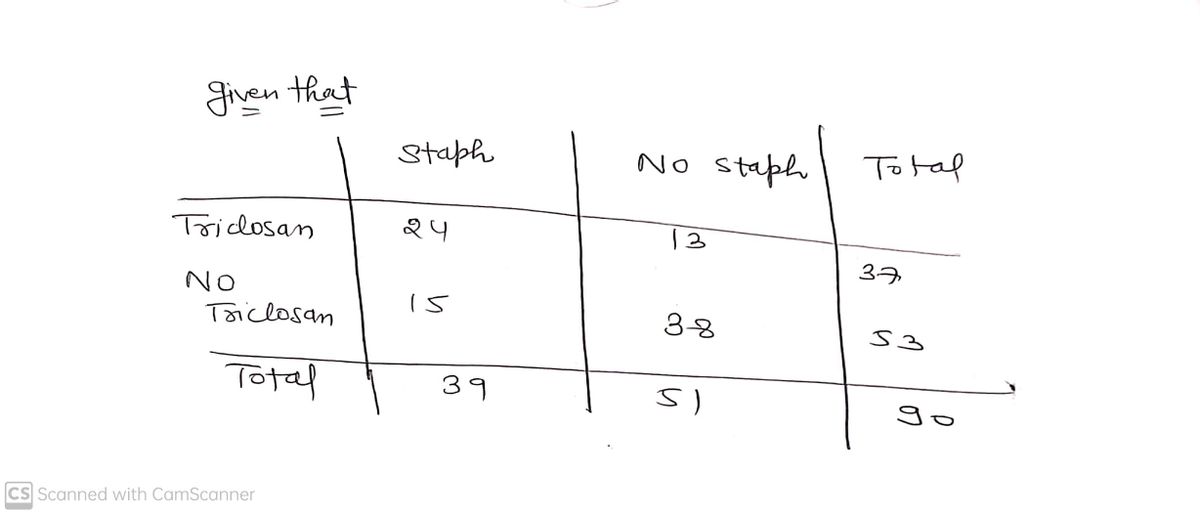Are Antimicrobial Ingredients Having the Opposite Effect? Triclosan is a compound often added to products such as soaps, lotions, and toothpaste. It is antimicrobial, so we expect it to lower one's chance of having a staph infection. However, the opposite was found in a recent study.¹ Microbiologists swabbed the noses of 90 people, and recorded which had detectable levels of triclosan and which had evidence of carrying the staph bacteria, which greatly increases one's chance of having a serious staph infection. The results are shown in the table below. P₁ = Triclosan P₂ = i No Triclosan Round your answers to three decimal places. P₁ = P₂ = Total i Staph 24 15 39 No Staph 13 38 Let group 1 be the people with triclosan in their system and group 2 be those without triclosan in their systems. Click here to access StatKey. ¹Mole B, "Triclosan aids nasal invasions by staph," Science News, April 15, 2014. 51 (a) What proportion of those with triclosan have the staph bacteria? What proportion of those without triclosan have the staph bacteria? What is the sample difference in proportions? Total 37 53 90
Are Antimicrobial Ingredients Having the Opposite Effect? Triclosan is a compound often added to products such as soaps, lotions, and toothpaste. It is antimicrobial, so we expect it to lower one's chance of having a staph infection. However, the opposite was found in a recent study.¹ Microbiologists swabbed the noses of 90 people, and recorded which had detectable levels of triclosan and which had evidence of carrying the staph bacteria, which greatly increases one's chance of having a serious staph infection. The results are shown in the table below. P₁ = Triclosan P₂ = i No Triclosan Round your answers to three decimal places. P₁ = P₂ = Total i Staph 24 15 39 No Staph 13 38 Let group 1 be the people with triclosan in their system and group 2 be those without triclosan in their systems. Click here to access StatKey. ¹Mole B, "Triclosan aids nasal invasions by staph," Science News, April 15, 2014. 51 (a) What proportion of those with triclosan have the staph bacteria? What proportion of those without triclosan have the staph bacteria? What is the sample difference in proportions? Total 37 53 90
MATLAB: An Introduction with Applications
6th Edition
ISBN:9781119256830
Author:Amos Gilat
Publisher:Amos Gilat
Chapter1: Starting With Matlab
Section: Chapter Questions
Problem 1P
Related questions
Question
16

Transcribed Image Text:(b) We wish to test to see if the effect found in the sample generalizes to the population. In testing to see if there is evidence that
people with triclosan are more likely to have staph bacteria, what are the null and alternative hypotheses?
Ho:
#
11
p-value =
H
MI
:: μ
vs Ha:¦
41
I₂
A
:: p
14₂
(c) Use StatKey or other technology to find the p-value for the test.
Round your answer to three decimal places.
:: p
^
:: P₁
:: P₁
A
:: P₂
:: P2
r
:: p
#I1

Transcribed Image Text:Are Antimicrobial Ingredients Having the Opposite Effect?
Triclosan is a compound often added to products such as soaps, lotions, and toothpaste. It is antimicrobial, so we expect it to lower
one's chance of having a staph infection. However, the opposite was found in a recent study.¹ Microbiologists swabbed the noses of 90
people, and recorded which had detectable levels of triclosan and which had evidence of carrying the staph bacteria, which greatly
increases one's chance of having a serious staph infection. The results are shown in the table below.
Click here to access StatKey.
Triclosan
P₁ =
No
Triclosan
P₂ = i
Total
P₁ = P₂ =
Staph
24
15
39
No Staph
13
38
¹Mole B, "Triclosan aids nasal invasions by staph," Science News, April 15, 2014.
51
Let group 1 be the people with triclosan in their system and group 2 be those without triclosan in their systems.
Total
37
53
(a) What proportion of those with triclosan have the staph bacteria? What proportion of those without triclosan have the staph
bacteria? What is the sample difference in proportions?
Round your answers to three decimal places.
90
Expert Solution
Step 1
Given that

We have to find
a..What proportion of those with triclosan have the staph bacteria? What proportion of those without triclosan have the staph bacteria? What is the sample difference in proportions?.
b..We wish to test to see if the effect found in the sample generalizes to the population. In testing to see if there is evidence that people with triclosan are more likely to have staph bacteria, what are the null and alternative hypotheses?
c..p value
Trending now
This is a popular solution!
Step by step
Solved in 4 steps with 3 images

Recommended textbooks for you

MATLAB: An Introduction with Applications
Statistics
ISBN:
9781119256830
Author:
Amos Gilat
Publisher:
John Wiley & Sons Inc

Probability and Statistics for Engineering and th…
Statistics
ISBN:
9781305251809
Author:
Jay L. Devore
Publisher:
Cengage Learning

Statistics for The Behavioral Sciences (MindTap C…
Statistics
ISBN:
9781305504912
Author:
Frederick J Gravetter, Larry B. Wallnau
Publisher:
Cengage Learning

MATLAB: An Introduction with Applications
Statistics
ISBN:
9781119256830
Author:
Amos Gilat
Publisher:
John Wiley & Sons Inc

Probability and Statistics for Engineering and th…
Statistics
ISBN:
9781305251809
Author:
Jay L. Devore
Publisher:
Cengage Learning

Statistics for The Behavioral Sciences (MindTap C…
Statistics
ISBN:
9781305504912
Author:
Frederick J Gravetter, Larry B. Wallnau
Publisher:
Cengage Learning

Elementary Statistics: Picturing the World (7th E…
Statistics
ISBN:
9780134683416
Author:
Ron Larson, Betsy Farber
Publisher:
PEARSON

The Basic Practice of Statistics
Statistics
ISBN:
9781319042578
Author:
David S. Moore, William I. Notz, Michael A. Fligner
Publisher:
W. H. Freeman

Introduction to the Practice of Statistics
Statistics
ISBN:
9781319013387
Author:
David S. Moore, George P. McCabe, Bruce A. Craig
Publisher:
W. H. Freeman